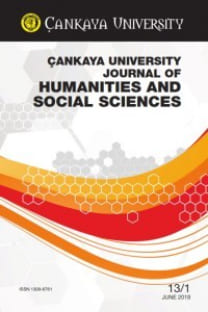İncil ile İlgili ve Tarihi Anıştırmaların Çevirisi: Christopher Marlowe’un Doktor Faustus’u Üzerine Bir Çalışma
çeviribilim, metinlerarasılık, anıştırma, Dr.Faustus
Translating Biblical and Historical Allusions: The Case of Doctor Faustus by Christopher Marlowe
translation studies, intertextuality, allusion, Doctor Faustus,
___
- Allen, Graham. Intertextuality. New York, Routledge, 2000.
- Ball, Kimberly. “The Devil’s Pact: Diabolic Writing and Oral Tradition.” Western Folklore, vol. 73, no. 4, 2014, pp. 385–409., www.jstor.org/stable/24551134. Accessed 11 May 2021.
- Baldick, Chris. The Oxford Dictionary of Literary Terms, Oxford University Press, Incorporated, 2015. ProQuest Ebook Central, https://ebookcentral.proquest.com/lib/baskent-ebooks/detail.action? docID=5824838.
- Britannica, The Editors of Encyclopaedia. “Queen of Sheba.” Encyclopedia Britannica, 13 Jan. 2021, https://www.britannica.com/biography/Queen-of-Sheba. Accessed 3 December 2020.
- Burnard, Philip. “A Method of Analysing Interview Transcripts in Qualitative Research.” Nurse Education Today, 11, 1991, pp. 461-466.
- Duxfield, Andrew. “Doctor Faustus and Renaissance Hermeticism.” Doctor Faustus: A Critical Guide, edited by Sara Munson Deats, Bloomsbury Publishing Plc, 2010. ProQuest Ebook Central, https://ebookcentral.proquest.com/lib/ baskent-ebooks/detail.action?docID=1749878.
- Greenblatt, Stephan and Abrams, M. H. editors. “Doctor Faustus.” The Norton Anthology English Literature, 8th ed., vol. 1, Norton, 2006, pp. 1023-55.
- Hoorens, Vera, and Hans Renders. “Heinrich Cornelius Agrippa and Witchcraft: A Reappraisal.” The Sixteenth Century Journal, vol. 43, no. 1, 2012, pp. 3-18. JSTOR, www.jstor.org/stable/23210753. Accessed 6 December 2020.
- Hopp, David. “Christopher Marlowe - Doctor Faustus Act 2.” Cassiodorus, 2020, www.cassiodorus.com/marlowe/F2notes.html. Accessed 6 December 2020.
- Jump, John D. Origins of Faustus Legend. Doctor Faustus. Taylor & Francis Group, 1990. ProQuest Ebook Central, https://ebookcentral.proquest.com/lib/ baskent-ebooks/detail.action?docID=241834.
- Kaličanin, Milena. The Faustian Motif in the Tragedies by Christopher Marlowe, Cambridge Scholars Publisher, 2013. ProQuest Ebook Central, https://ebookcentral.proquest.com/lib/baskent-ebooks/detail.action? docID=1753174.
- Kristeva, Julia. The Kristeva Reader edited by T. Moi. New York, Columbia University Press, 1986.
- Leppihalme, Rita. Culture Bumps: An Empirical Approach to the Translation of Allusions Topics in Translation. e-book, Multilingual Matters, 1997.
- Losada, Jose. The Myth of the Fallen Angel, 2004, https://www.researchgate.net/ publication/300016725_The_Myth_of_the_Fallen_Angel. Accessed 20 November 2020.
- Lukacs, Peter. The Tragical History of Doctor Faustus. http://elizabethandrama.org/ wp-content/uploads/2018/05/Doctor-Faustus-A-Text-Annotated-Plain.pdf. Accessed 26 November 2020.
- Mackie, Tim. Why Pharaoh’s Heart Grew Hard. https://bibleproject.com/blog/ pharaohs-heart-grew-harder. Accessed 6 December 2020.
- Marlowe, Christopher. Doctor Faustus, edited by John D. Jump, Taylor & Francis Group, 1990. ProQuest Ebook Central, https://ebookcentral.proquest.com/ lib/baskent-ebooks/detail.action? docID=241834.
- Marlowe, Christopher. “The Tragical History of Doctor Faustus.” The Norton Anthology English Literature, edited by A. S. Greenblatt and M. H. Abrams, 8th ed., vol. 1, Norton, 2006, pp. 1023-55. Marlowe, Christopher. Dr. Faustus. Translated by T. Yılmaz Öğüt. Mitos Boyut, 2018.
- Mikics, David. A New Handbook of Literary Terms, Yale University Press, 2007. ProQuest Ebook Central, https://ebookcentral.proquest.com/lib/ baskent-ebooks/detail. action?docID=3420303.
- Ruffner, Frederick G., and Laurence Urdang. Ruffner’s Allusions: Cultural, Literary, Religious, and Historical: A Thematic Dictionary, edited by Harris, Laurie Lanzen, and Sharon R Gunton, Omnigraphics, Incorporated, 2009. ProQuest Ebook Central, https://ebookcentral.proquest.com/lib/baskentebooks/ detail.action? docID=3384034.
- Polit, D. F. and Beck, C. T. Essentials of Nursing Research Methods, Appraisal, And Utilization, Lippincott Williams & Wilkins, 2006.
- Venuti, Lawrence. “Translation, Intertextuality, Interpretation.” Romance Studies, vol. 27, no. 3, 2009, pp. 157-73. Crossref, doi:10.1179/174581509x455169.
- Zhao, Honghui. “An Intertextual Approach to Translation at the Micro-Level.” Open Journal of Social Sciences, vol. 05, no. 11, 2017, pp. 119-27. Crossref, doi:10.4236/jss.2017.51
- ISSN: 1309-6761
- Yayın Aralığı: Yılda 2 Sayı
- Başlangıç: 2004
- Yayıncı: Çankaya Üniversitesi
Asterix’te Özel İsimlerin Sinhala’ya Çevirisi Üzerine
Samanthi JAYAWARDENA, Judith Sumindi RODRİGO
Chaucer’ın Düşes’in Kitabı adlı Şiirinde Hastalık ve İyileşmeye Dair
Türkçe’de Kanıtsallığa Kullanıma Dayalı Yapı Gramer Yaklaşımı: Kanıtsallık Yapısı
Varoluşculuğun İmgeleri: Heidegger, Camus, and Levinas
Berlin’in Psikocoğrafyası: David Hare’in Berlin ve Mark Ravenhill’in Over There Adlı Oyunları
